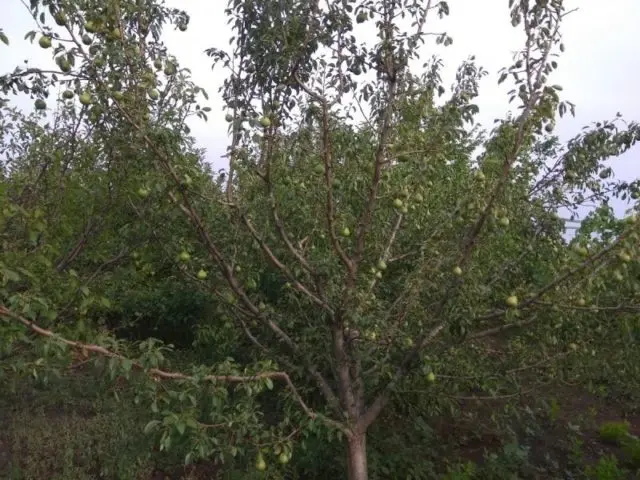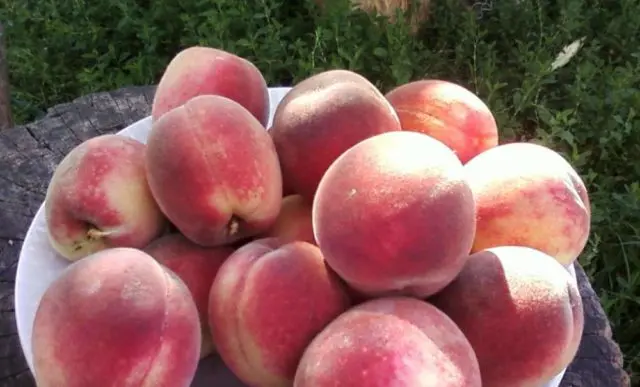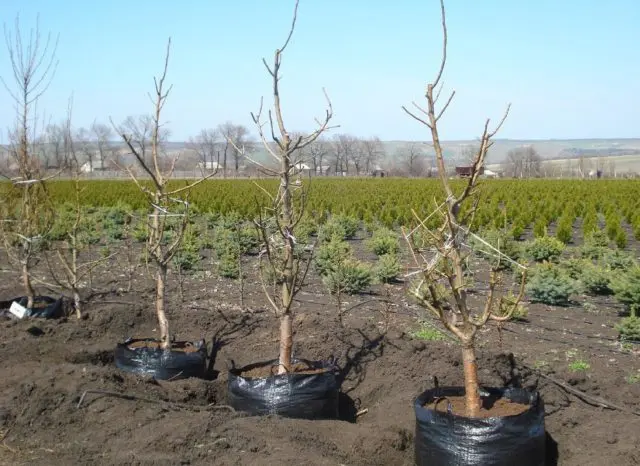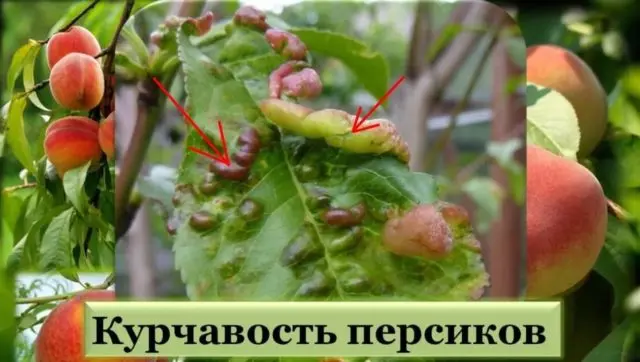Contents
Peach Golden Jubilee has not lost its popularity for many years. The tree is famous for large yields, tasty fruits and good immunity. Growing a variety is easy, even a novice gardener can handle this task.
History of variety breeding
The Golden Jubilee peach variety was developed in 1920 in America by crossing two varieties: Elberta and Greensboro. Breeders were faced with the task of developing a hardy tree in order to get an environmentally friendly crop from it. The variety was intended for the American elite, it became widespread only in the post-war years. In 1947, it was entered into the State Register.
Description
The description indicates that the Golden Jubilee peach is a table variety, the photo shows that the tree is of medium height with a spreading crown. It grows rapidly, in a few years it reaches the maximum height – 5 m. The leaves are wide, yellow-green, the edges are serrated. The flowers are bright pink, medium size, bell-shaped, concave petals. Flowering is abundant, occurs in mid-May. The ovary is formed well.

Fruiting variety occurs in the fourth year of cultivation. Peaches Golden Jubilee are large, the average fruit weight is 140 g, rounded with an oval top. Peel medium density, honey color with a characteristic blush. The pubescence is not strong. In the cut, the flesh is bright orange, fibrous, sweet and sour, juicy. The stone is small, brown-red in color, well separable. The stem is small.
Variety Golden Jubilee is zoned for the North Caucasus region. However, he showed good results when grown not only in dry and hot climates. It is successfully cultivated in damp and humid regions. The variety adapts well to any climatic conditions.
Characteristics of the peach variety Golden Jubilee
Peach Golden Jubilee fell in love with gardeners due to its characteristics. It is hardy, with good immunity and stable yield.
Drought resistance, frost resistance
The variety painlessly tolerates a drop in temperature to -25 ° C. Winter hardiness of flower buds and shoots is high. The tree is frost tolerant. It winters well in the steppe regions of the Crimea, where there are snowless winters. In the conditions of the middle zone and in the North, it is not worth growing without additional shelter for the winter.
Peach adapts well to hot conditions, does not require special care during the dry period.
Does the variety need pollinators?
The Golden Jubilee variety is completely self-fertile, but the yield without cross-pollination is lower than stated. To collect many delicious fruits, you need to grow trees in the garden with a suitable flowering period.
Good pollinators for the Golden Jubilee variety:
- Stavropol pink;
- Harness;
- Volcano;
- Funnel.
Alone, they bear fruit unstable, when planted together, the results are much better.
Yield and fruiting
Peach Golden Jubilee is very fruitful. With age, the indicators only increase. The average yield of a ten-year-old tree is within 50 kg. It is possible to collect up to 65 kg of fruit as much as possible, but for this you need to properly care for the variety.

The Golden Jubilee peach variety bears fruit in the first half of August. The photo shows that the fruits are of high quality. The return of the harvest is friendly, the peaches must be harvested within a week, otherwise they will fall off. Ripe fruits do not hold well on the branches.
Golden Anniversary peaches are fragrant, have excellent taste, and have good commercial characteristics. The variety is suitable for industrial cultivation.
Scope of fruits
The fresh crop is stored for no more than 5 days, so it is immediately processed. The variety is suitable for whole-fruit canning, making jams, compotes, drying.
Ripe peaches are transported poorly; they cannot be transported over long distances. Fruits quickly lose their presentation.
Disease and pest resistance
The Golden Jubilee tree is highly disease resistant. He is not afraid of such diseases:
- powdery mildew;
- clusterosporiosis.
However, the variety is strongly affected by leaf curl. Needs preventive treatments.
Advantages and disadvantages of the variety
Among the advantages of the Golden Anniversary variety, high yields, good commercial qualities of fruits and their taste stand out. Immunity and winter hardiness of peach depend on care.
Despite the good characteristics, the variety has a number of shortcomings that you need to know about before planting:
- Low fruit transportability and short shelf life.
- The tendency of the crop to shed.
- Average winter hardiness for the northern regions.
- The need for preventive treatments against pests and diseases.
In general, the Golden Jubilee variety takes root well and grows in different regions of the country, but some effort is needed for this.
Peach planting rules
The Golden Jubilee peach variety can be grafted onto almonds and cherry plums, while the tree bears fruit equally well. Experienced gardeners recommend using apricot as a rootstock.
Recommended dates
In the recommended regions, the Golden Jubilee peach planting is planned for autumn. In the middle lane, the variety is planted in early spring.
The main rule is to plant a tree when it is in a dormant period. In the spring before the start of sap flow, in the fall – after leaf fall.
Choosing the right place
It has been noticed that the Golden Jubilee peach grows well and develops only on loose, sandy or loamy soils.
The landing site is chosen quiet, calm, well lit, with low groundwater. The south, southwest or west side of the site is ideal. It will be good if the tree is fenced on one side with a fence, wall or other buildings.
Selection and preparation of planting material
Further fruiting and viability depend on what the seedling will be. When choosing a planting material, you need to pay attention to the following factors:
- root system;
- skeletal branches;
- place of vaccination;
- tree age.
For planting, choose an annual seedling with a well-developed root system. This plant grows best. The roots should be without visible damage, not dry, not affected by diseases, on a white cut. The skeletal branches of the tree are symmetrical.

Particular attention should be paid to the place of vaccination. A good root neck is firm, without sagging and juice.
If transportation is to be carried out, then the peach roots are wrapped in a damp cloth and packed in a bag. Before planting, the seedling is soaked for 12 hours in a bucket of water so that the shoots are saturated with moisture.
Landing algorithm
A pit for planting is prepared in advance. Its standard size is 50 x 50 cm. The site is dug up, mineral fertilizers and organic matter are applied. It is advisable to use ash, manure, superphosphate.
Starting planting, fertile soil is mixed with complex mineral fertilizers. The seedling is set in the center of the pit, the roots are straightened and sprinkled with soil. Well compacted and watered abundantly. The trunk circle is mulched with humus or straw.
Peach Aftercare
Peach roots need access to oxygen. The trunk circle is regularly loosened, freed from weeds. The rest is standard care.
Watering is carried out several times a season, abundantly wetting the soil. If the weather is rainy, then additional moistening of the soil is not necessary. Enough natural moisture.
For abundant fruiting, top dressing is used. They are introduced in the second year after planting, if the pit was filled in accordance with all the rules. Preference is given to phosphorus-potassium fertilizers.
To increase winter hardiness and productivity, the crown must be cut off. Formation is carried out throughout the season. In the spring they are pruned “on a pink bud”, then in the middle of summer and after harvesting.
In the spring, dry, broken, twisted branches are cut out. Rejuvenate old peaches. In summer, sanitary cleaning is carried out, diseased and thickening shoots are removed. In autumn, a crown is formed and branches broken from the harvest are removed.
After harvesting, the tree is prepared for winter. The trunk is cleaned from the old bark, all wounds and cracks are covered with garden pitch, treated with lime with the addition of copper sulfate. In late autumn, water-charging watering is carried out so that the roots and shoots do not dry out in winter. To do this, the soil around the seedling is abundantly moistened with water to a depth of 50 cm.
Diseases and pests, methods of control and prevention
Peach Golden Jubilee is often affected by curliness. In the photo you can see what the tree looks like. The disease is dangerous, it can completely destroy the peach. To prevent this from happening, it is necessary to carry out preventive treatment with copper-containing preparations. Spraying is done in early spring and autumn. It is allowed to use 3% Bordeaux liquid, copper sulfate and such preparations:
- “Oxychom”;
- “Raek”;
- “Score”.
In addition, these funds have a complex effect, will help get rid of other diseases.

As a pest prevention, spraying with complex insecticides is carried out.
Conclusion
Peach Golden Jubilee, despite some shortcomings, is recommended for cultivation. If you follow all the rules of planting and take good care of the plant, you can regularly harvest a rich harvest of juicy fruits.









